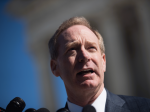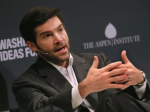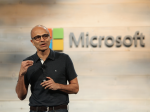AP
When Satya Nadella was named CEO of Microsoft in 2014, the company was in pickle.
Apple and Google were demolishing Microsoft in the smartphone business — thus, chipping away at the dominance of the Windows computing platform. That was compounded by the lukewarm response to Windows 8, which was then the latest version.
But then, Nadella took over for his predecessor, Steve Ballmer. Microsoft corrected the course, made some big deals —like $2.5 billion for Minecraft-maker Mojang and $26.2 billion for LinkedIn — and refocused on growth businesses like cloud computing. Now, the stock is hitting all time highs, and Microsoft is back on track.
Nadella leaned on an A-Team of Microsoft veterans and some new recruits to capitalize on key businesses and to put the turnaround plan into action. Here's the group of execs that made it happen:
Scott Guthrie, executive vice president of the Microsoft Cloud and Enterprise GroupStephen Lam/Getty ImagesScott Guthrie is, by and large, Nadella's right hand man.
He's charge of Microsoft's cloud computing platform, Azure, as well as all of its enterprise software and services. Those are Microsoft's fastest-growing businesses, making him a key player.
Azure is taking on Amazon Web Services and Google Cloud in the lucrative cloud computing market. Right now, Azure is the second-place player to the market-leading Amazon Web Services— but Azure revenue last quarter was up 98% from the year-ago period, according to Microsoft's latest earnings report.
He's been at Microsoft for over two decades, but is perhaps best known among developers for his work in creating the open source framework ASP.NET.
Phil Spencer, executive vice president of gamingChristian Petersen/Getty Images
Phil Spencer is in charge of Microsoft's gaming efforts, including the Xbox One console and games on Windows 10. He's also in overall charge of Minecraft, the smash-hit phenomenon that Microsoft purchased for $2.5 billion.
And Microsoft is taking gaming seriously: As of last year, Spencer was promoted to the title of executive VP, meaning he now reports directly to CEO Nadella.
And he has ambitious plans to take on Sony's PlayStation 4 and the Nintendo Switch — notably, by introducing Xbox Game Pass, a $10/month service that gives Netflix-style unlimited access to a growing list of games.
Terry Myerson, executive vice president of the Windows and Devices Group.Drew Angerer/Getty Images
Terry Myerson is in charge of Microsoft Windows — still the most popular PC operating system in the world.
Also under his purview are bigger bets for Microsoft, including the Surface line of desktop and laptop computers, as well as the HoloLens augmented reality headset. Plus, he's in charge of many key tools that enterprises use to manage their Windows PCs, including InTune and Advanced Threat Protection.
Myerson joined Microsoft in 1997 after the company acquired his software company, Intersé.
Peggy Johnson, executive vice president of Business DevelopmentMicrosoft
Peggy Johnson is Microsoft's "dealmaker-in-chief." She helped lead the $26 billion dollar acquisition of LinkedIn. Elsewhere in Silicon Valley, she's masterminded many of Microsoft's venture capital investments in startups.
Nadella hired Johnson in 2014, not long after he was named CEO. He wanted Johnson to spearhead partnerships that would see Microsoft cooperate with outside companies. That's resulted in big acquisitions like LinkedIn, as well as partnerships with firms like Dun & Bradstreet.
Before Microsoft, Johnson worked at chipmaker Qualcomm for 24 years, serving as a member of Qualcomm’s Executive Committee.
Amy Hood, CFOStephen Brashear/Getty Images
Hood joined Microsoft in 2002 after a stint and Goldman Sachs and quickly rose through the ranks.
At one time, Hood served as chief financial officer of Microsoft’s Business Division. In that role, she helped oversee the acquisitions of Skype and Yammer. She was promoted to CFO of the entire company in 2013.
Now, she plays a crucial role managing Microsoft's considerable investments in cloud computing and data centers, which requires big spending in both real estate and technology. Plus, she's been key in the company's efforts to reorient businesses like Microsoft Office around subscription-based revenue models, rather than selling boxed software.
See the rest of the story at Business Insider
See Also:
- MuleSoft's plan to be acquired by Salesforce could make founder Ross Mason a $300 million man
- This startup does $10 million in annual revenue with almost no investor money — now it's trying to reinvent how web design works
- Cryptokitties, which is like Beanie Babies on the blockchain, just got $12 million from Andreessen Horowitz














